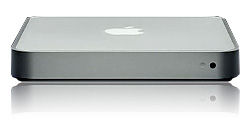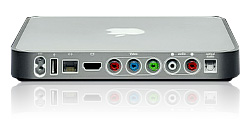 Apple Computer today previewed their upcoming media hub, a device looking like a thinner version of the Mac mini, cabable of streaming video and audio from a computer to a TV. The device, with working name iTV, will connect through a wireless network to computers and connects to a TV using HDMI/component video and optical audio cables.
Apple Computer today previewed their upcoming media hub, a device looking like a thinner version of the Mac mini, cabable of streaming video and audio from a computer to a TV. The device, with working name iTV, will connect through a wireless network to computers and connects to a TV using HDMI/component video and optical audio cables.

 Together with the launch of the new iTunes Store, with full length movie downloads in DVD quality (full VGA resolution, up from 320x240), Apple takes one step further into the living room, something we will see more of next year according to analysts.
Together with the launch of the new iTunes Store, with full length movie downloads in DVD quality (full VGA resolution, up from 320x240), Apple takes one step further into the living room, something we will see more of next year according to analysts.
At the same time, Apple also introduced the second generation iPod nano, upgrading the top model to 8 GB storage and adding color options, increased battery time to 24h, all in an even thinner anodized aluminum casing.
 Other updates include a newly designed and much smaller iPod shuffle 1GB, and updates of the flagship iPod model with more storage and brighter screens.
Other updates include a newly designed and much smaller iPod shuffle 1GB, and updates of the flagship iPod model with more storage and brighter screens.
www.apple.com




 Apple Computer today previewed their upcoming media hub, a device looking like a thinner version of the Mac mini, cabable of streaming video and audio from a computer to a TV. The device, with working name iTV, will connect through a wireless network to computers and connects to a TV using HDMI/component video and optical audio cables.
Apple Computer today previewed their upcoming media hub, a device looking like a thinner version of the Mac mini, cabable of streaming video and audio from a computer to a TV. The device, with working name iTV, will connect through a wireless network to computers and connects to a TV using HDMI/component video and optical audio cables.
 Together with the launch of the new iTunes Store, with full length movie downloads in DVD quality (full VGA resolution, up from 320x240), Apple takes one step further into the living room, something we will see more of next year according to analysts.
Together with the launch of the new iTunes Store, with full length movie downloads in DVD quality (full VGA resolution, up from 320x240), Apple takes one step further into the living room, something we will see more of next year according to analysts.






